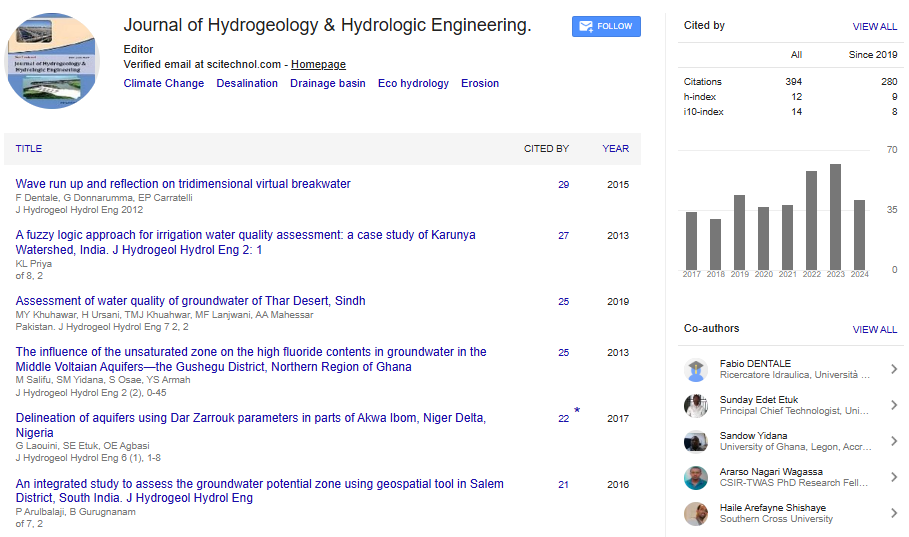Perspective, J Hydrogeol Hydrol Eng Vol: 13 Issue: 6
The Importance and Dynamics of River Water in Ecosystems and Human Development
Marcus Li*
1Department of Earth Sciences, Indian Institute of Technology, Roorkee, India
*Corresponding Author: Marcus Li,
Department of Earth Sciences, Indian
Institute of Technology, Roorkee, India
E-mail: limarcus45@gmail.com
Received date: 26 November, 2024, Manuscript No. JHHE-24-154122;
Editor assigned date: 28 November, 2024, PreQC No. JHHE-24-154122 (PQ);
Reviewed date: 12 December, 2024, QC No. JHHE-24-154122;
Revised date: 20 December, 2024, Manuscript No. JHHE-24-154122 (R);
Published date: 27 December, 2024, DOI: 10.4172/2325-9647.1000352
Citation: Li M (2024) The Importance and Dynamics of River Water in Ecosystems and Human Development. J Hydrogeol Hydrol Eng 13:6.
Description
Rivers are vital lifelines for ecosystems and human societies, playing an essential role in maintaining environmental balance and supporting economic development. These flowing water systems are dynamic and multifaceted, offering sustenance to countless living organisms while shaping landscapes over millennia. This article explores the significance of river water and its difficult relationship with life on Earth.
Rivers act as arteries of the planet, transporting nutrients and sediments from land to oceans. This movement sustains aquatic ecosystems and replenishes fertile soils along riverbanks, creating lush environments for agriculture and biodiversity. Freshwater species, from fish to amphibians, thrive in these habitats, while terrestrial animals rely on rivers as a steady source of drinking water. Wetlands connected to rivers further amplify their ecological value by serving as breeding grounds for various species and natural filters for pollutants.
The interconnectedness of river ecosystems means that any disturbance in their flow or quality can have dropping effects. For instance, dam construction or excessive water extraction can disrupt migration patterns of fish and alter the natural flooding cycles essential for nutrient distribution.
Rivers have historically been the cradle of civilizations. After the Nile in Egypt to the Indus in South Asia, human settlements have flourished along riverbanks due to access to water for drinking, irrigation and transportation. Today, rivers continue to be indispensable for urban and rural communities. They supply water for domestic use, industrial processes and agriculture, contributing to food security and economic growth.
Hydropower generation is another precariou s aspect ohfu man reliance on rivers. By connecting the kinetice nergy of flowing water, dams provide renewable energy to millions of households and industries. However, this comes with trade-offs, as altering river flow for energy production can have environmental and social consequences.
Despite their immense value, rivers face numerous threats, many of which are anthropogenic. Pollution from industrial discharge, agricultural runoff and untreated sewage significantly degrades water quality, impacting both ecosystems and human health. Additionally, climate change improves these issues by altering rainfall patterns and increasing the frequency of droughts and floods.
Another major challenge is over-extraction. In many regions, rivers are being drained faster than they can replenish, leading to reduced flow and shrinking water tables. This unsustainable practice threatens not only local ecosystems but also the long-term availability of water for human use.
Beyond their ecological and economic importance, rivers hold cultural and spiritual significance for many communities. Rituals, festivals and traditions often revolve around rivers, symbolizing purity and life. Recreational activities like boating, fishing and riverside picnics also highlight their role in enhancing human well-being.
In recent years, riverfront development projects have gained popularity, aiming to integrate rivers into urban landscapes. These initiatives often combine environmental restoration with the creation of public spaces, adopting a stronger connection between people and their natural surroundings.
The sustainability of river systems depends on collective efforts from governments, communities and individuals. Policies that regulate pollution, promote water conservation and encourage sustainable development are essential for preserving river ecosystems. Public awareness campaigns can further empower citizens to take active roles in protecting their local rivers.
Technological advancements also offer promising solutions. Innovations in wastewater treatment, real-time water quality monitoring and eco-friendly agricultural practices can ease some of the challenges facing river water. Additionally, restoring riparian zones and adopting integrated water resource management approaches can help balance ecological and human needs.
Conclusion
River water is an irreplaceable resource that underpins both natural ecosystems and human prosperity. As pressures on these vital systems intensify, it is imperative to prioritize their protection and sustainable use. By valuing and safeguarding rivers, we ensure a healthier, more strong future for all life forms dependent on this precious resource.
 Spanish
Spanish  Chinese
Chinese  Russian
Russian  German
German  French
French  Japanese
Japanese  Portuguese
Portuguese  Hindi
Hindi 
